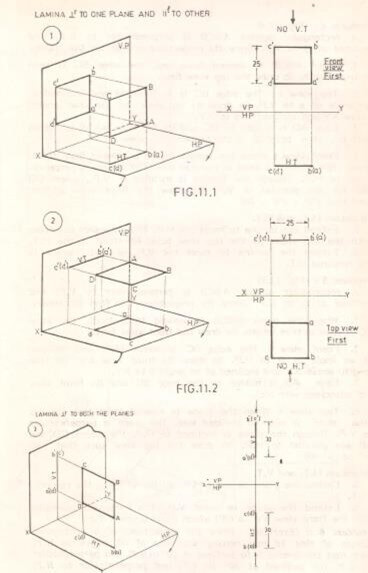Projection Of Planes Assignment Help
Plane figures: A plane figure or surface has only two dimensions, i.e., length and breadth. It has no thickness. A plane may be of any shape, such as triangular, square, pentagonal, hexagonal, circular etc.
Traces of planes: A plane, extended if necessary, will meet the reference planes in lines unless it is parallel to any one of them. These lines are called traces of the plane.
Horizontal Trace (H.T.) of a plane is the line in which the plane meets the H.P. Vertical Trace (V.T.) of a plane is the line in which the plane meets the V.P.
Types of planes: Planes may be divided into two types- perpendicular planes and oblique planes.
Perpendicular planes: The planes which are perpendicular to one or both the reference planes are called perpendicular planes. They can be sub-divided into the following three types-
- Perpendicular to one plane and parallel to the other.
- Perpendicular to both the planes.
- Perpendicular to one plane and inclined to the other.
Projection Of Planes Assignment Help By Online Tutoring and Guided Sessions from AssignmentHelp.Net
Oblique planes: The planes which are inclined to both the reference planes are called oblique planes.
Lets take a square lamina ABCD of side 25 mm in perpendicular to H.P. and parallel to V.P. Lamina is parallel to V.P. and when viewed from the front it is seen in true shape and size. Therefore draw the front view first.
1. Front view: The lamina ABCD is above H.P. So draw its front view abcd in true size above XY.
2. Top view: When the plane is viewed from the top, edge BC is seen in true length and parallel to the V.P. So draw its top view bc (in true length) parallel to and below XY.
3. To mark invisible cameras in the top view: Look at the front view in the direction of arrow shown a and d are hidden and b and c respectively. Therefore in the top view, ad coincides with bc and is marked as (a)(d). Now bc(d)(a) is top view.
4. Extend the plane to meet the H.P. The extension coincides with the top view. So the top view bc(d)(a) itself is the H.T.
5. Extend the plane to meet the V.P. Since the plane is parallel to V.P. it will not meet it and hence no V.T.



